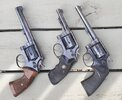On S&W DA trigger pulls there are two clicks. The first click is when the cylinder stop pops out of its retracted position and hits the cylinder. This happens about 1/2 way through the pull. The second click is when the cylinder stop slides into the notch in the cylinder. This locks the cylinder in place so it is in alignment with the barrel. If you hear the second click before the hammer drops, it means your gun has good DA timing. It is desirable.
Some folks "stage" their DA pull in which they press the trigger quickly to rotate the cylinder quickly so it locks in place via the cylinder stop. Then they press slowly until it goes bang.
Yep, in the revolver armorer class I took as a S&W armorer for my agency, the instructor discussed checking carry-up. Part of the check was to make sure the cylinder stop's ball popped up and fully engaged in each of the cylinder's stop notches during DA no later than hammer fall. Early carry-up was said to be fine (and I prefer it), meaning the cylinder stop's ball would click into the cylinder's stop notches before the DA hammer fell. We were told the normal spec was that it engaged in the cylinder (locking the cylinder in place)
no later than hammer fall (which means you wouldn't hear it happening because of the hammer fall and firing).
There's no way to know what's happening with the OP's gun. Not without being there to inspect it in person. That said, for the sake of discussion ...
OP, if you're pulling through the DA trigger stroke
so slowly that you're hearing/feeling the click of the
cylinder stop's ball snapping up into a cylinder stop
notch just before the hammer falls, it may just mean you're pulling through the press so slowly that if your extractor ratchets were cut so you have early carry-up, it's letting you hear/feel the cylinder stop's movement before DA hammer fall. If it were me, I'd have the gun checked by a competent smith familiar with S&W revolvers, or call the factory and see if they'll send you a shipping label for them to inspect it under warranty. Best to find out what's happening, and whether or not it requires correction. If it's a defect, they might want to correct it even if you're not the original owner. If it's due to some tinkering under the hood (you get it new?), they may want your credit card number to make the repair.
Stubbing (hammer's DA sear stubbing against the trigger's rear cam lobe) can cause problems. In older S&W's the hammer sear required fitting, and there are 3 'cuts' on the sear (long & short on the bottom, and at the top/rear) that may be involved in such fitting. In the current S&W New Model revolvers, with MIM, we were told that a factory-cut MIM hammer sear would probably drop into 90% of the guns (MIM hammers) without any further fitting. I much prefer the new tolerances and specs, myself.

Less work needed.
Just my thoughts. Good luck in getting it figured out.


